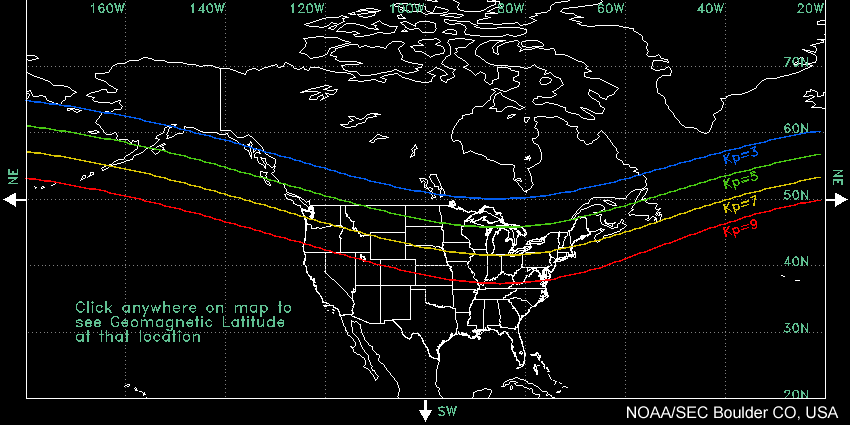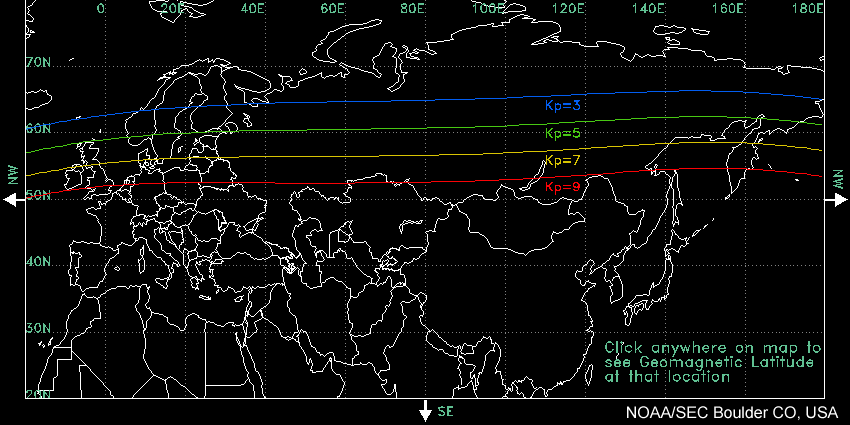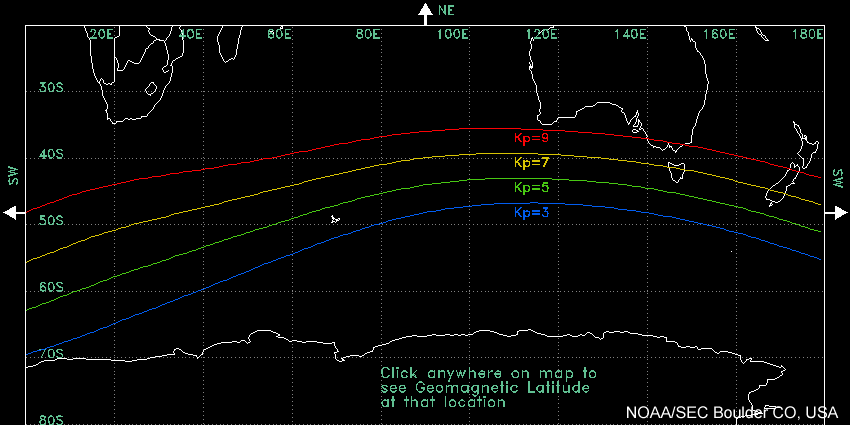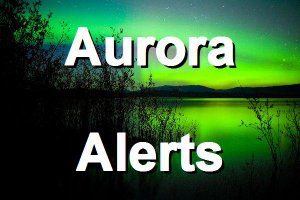Why even get Aurora Alerts?

Aurora Three Day Forecast --
By JIM THOMAS -- Soft Serve News
The charts below show the Aurora forecast for up to the next 3 days. They estimate the maximum Kp numbers for various times throughout the day. The larger the Kp number, the larger the Aurora -- and the further south it can be seen. You should always know what Kp number you need for your location. You can find your Kp number for your location from the maps shown below.
IMPORTANT NOTE ABOUT THESE FORECASTS:
Are these 3-day forecasts accurate? Unfortunately, they're not as accurate as everyone would like. The state of the science is that multi-day forecasts are sketchy at best. So why include them at all? We include them because 1) these are the official NOAA forecasts and 2) they can give a general sense of the Aurora one or two days out.
If you are looking for the forecast for the next few minutes, the real time Aurora Borealis Forecast should be used. (If you are interested in the Southern Lights, use the real time Aurora Australis Forecast.) It is more accurate for what is happening right now than the below charts.
Note: all the information on this page is automatically in your local date and time.
The red line is the current time. To zoom, select an area with mouse or finger-spread on phone. (Refresh to update.)
WILL YOU BE ABLE TO SEE THE AURORA?
To determine if you can see the Northern Lights use the following three steps:
Step 1 -- Know your Location's "KP number."
The KP number is the Geomagnetic Activity Level. The stronger the Aurora, the larger the KP number and the further south it can be seen. Find the KP number for your location on the one of the maps below. Use the above charts to plan ahead for nights that might be good for watching the Aurora. On the night you wish to view, periodically check the real-time Aurora Borealis Forecast. (Or if you are interested in the Southern Lights, use the real time Aurora Australis Forecast.) This will give you the KP number prediction for the Aurora for the next hour or so. If that number is greater or equal to the number on the map for your location, you're in luck. Even if the predicted number is one point too low, it still might be worth a look.
North America

Europe & Asia

Australia and New Zealand (Southern Lights)

Step 2 -- Check the Weather.
Auroras happen in the upper atmosphere, so if there are clouds blocking your view of the stars, you won't be able to see the Aurora.
Step 3 -- Shop for a Dark Spot.
Get away from those city lights. Darkness is best for viewing the Aurora. The fewer competing light sources, the better. But it is also very important to remember the widest part of the Aurora is when the sun is on the opposite side of the earth. So late, nighttime (or early morning) dark tends to be best.


The charts below show the Aurora forecast for up to the next 3 days. They estimate the maximum Kp numbers for various times throughout the day. The larger the Kp number, the larger the Aurora -- and the further south it can be seen. You should always know what Kp number you need for your location. You can find your Kp number for your location from the maps shown below.
IMPORTANT NOTE ABOUT THESE FORECASTS:
Are these 3-day forecasts accurate? Unfortunately, they're not as accurate as everyone would like. The state of the science is that multi-day forecasts are sketchy at best. So why include them at all? We include them because 1) these are the official NOAA forecasts and 2) they can give a general sense of the Aurora one or two days out.
If you are looking for the forecast for the next few minutes, the real time Aurora Borealis Forecast should be used. (If you are interested in the Southern Lights, use the real time Aurora Australis Forecast.) It is more accurate for what is happening right now than the below charts.
Note: all the information on this page is automatically in your local date and time.
To determine if you can see the Northern Lights use the following three steps:
Step 1 -- Know your Location's "KP number."
The KP number is the Geomagnetic Activity Level. The stronger the Aurora, the larger the KP number and the further south it can be seen. Find the KP number for your location on the one of the maps below. Use the above charts to plan ahead for nights that might be good for watching the Aurora. On the night you wish to view, periodically check the real-time Aurora Borealis Forecast. (Or if you are interested in the Southern Lights, use the real time Aurora Australis Forecast.) This will give you the KP number prediction for the Aurora for the next hour or so. If that number is greater or equal to the number on the map for your location, you're in luck. Even if the predicted number is one point too low, it still might be worth a look.



Step 2 -- Check the Weather.
Auroras happen in the upper atmosphere, so if there are clouds blocking your view of the stars, you won't be able to see the Aurora.
Step 3 -- Shop for a Dark Spot.
Get away from those city lights. Darkness is best for viewing the Aurora. The fewer competing light sources, the better. But it is also very important to remember the widest part of the Aurora is when the sun is on the opposite side of the earth. So late, nighttime (or early morning) dark tends to be best.
Remember if you don't know about the Aurora, you might miss it. Get Aurora Alerts.

